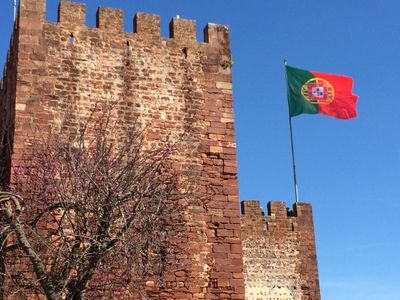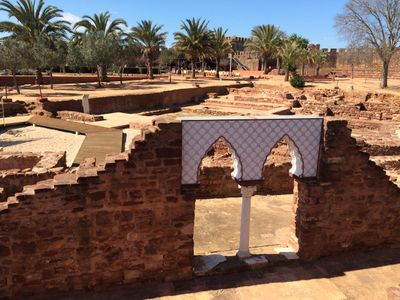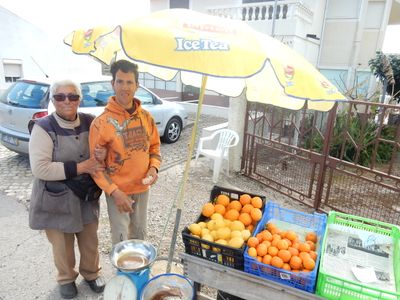Embedding photos is still a bear with my iPad. But if you want to follow along, here's a photo gallery covering the areas we went to in this post.
After our tour of dolmans and megaliths was over, Libanio dropped us off near our apartment. We ran upstairs, grabbed our bags and walked ("with purpose" as Cindy says) down the alley,through the city gate, down the road to the bus depot and straight on the bus to Faro. Five minutes early, I might add!
Faro is the capital of the Algarve region of Portugal. It's the most southern strip of the country, bordering Alentejo on the north, the Atlantic Ocean on the west, Spain on the east and the Mediterranean Sea on the south. You might say it's the Tourist Area - pretty much all my Canadian friends who tell me of their winter escapes to Portugal go to the Algarve for the beaches, golf and food.
But before we could see the beach, we had to go through the mountains on the northern border of the Algarve. While not tall be Rocky Mountain standards, they were a big change from the rolling hills of Alentejo. While we travelled on the main north/south highway, we traveled straight through, but as we exited for the various bus stops on the way the roads twisted and turned quite a bit.
I will admit, our first impression of Faro was poor. But we were on the bus, travelling too fast past hotels, shopping malls and outlet stores. And of course the bus depot was in a seedier area of town. But as we walked to our guest room for the next two nights, the streets opened up and it was really quite nice.
We were staying in the "old city" which dates back to the 13th century and was full of our favourite narrow cobblestone streets. And just outside the city walls were 6-8 twisty blocks of pedestrian only streets full of shops, pastelarias, gelaterias and restaurants. Plus, being on the Mediterranian coast, Faro had a harbour, with a long promenade that we walked at least six times, to and from our room.
While the weather was sunny and mild for us, around 18C, you could tell it gets hot in the summer, since all the streets had white sailcloth stretched between the buildings, providing shade for the shoppers. So we walked around the shopping district, then over to the public garden (with more of my coffee kiosks!) and to the local library. We spent an hour browsing the stacks, looking for books we recognized, even if we couldn't read them since they were all in Portuguese. Although I did browse through an interesting history of Portuguese postage stamps and learned stamps were called "selo", which really would've helped at the post office in Evora.
Now we were at a crossroads. Before we left home, we planned on traveling to the Atlantic side of the Algarve, but the bus schedules were against us. Many of the areas we wanted to visit are hard to get to in the height of summer, and are pretty much impossible to reach in low season. One bus in at 9AM, one out at 9PM, etc. We'd be spending all our time and money on bus rides and not see anything. So we decided to break our pre-trip promise and rent a car. We found a place near the airport which rented cars with automatic transmissions (they had exactly one in stock) and after promising with our lives that we wouldn't damage it further (it was already missing one light and had dents in all four corners and all four sides) we were on the highway to Monchique.
A brief word about European cars. I love them. We were driving a Citroen, and though I really wanted a tiny Fiat, or a jazzy Renault even, the Citroen was fine. But their automatic transmissions are really strange. I think they just took a manual and slapped a robot shifter on it. There's no "Park" so the car will still roll on you and shifting through the first three gears was as rough as if I were shifting myself. Plus there's 'eco' mode, where the engine shuts off at stops and restarts when you release the brake. I thought it was stalling for the longest time. I will learn to drive a manual next trip, I promise.
With all the taxis to the airport, rental contract stress and 'Eco' mode, I was getting rather agitated. Hungry too, because we did all this before breakfast. So we decided to stop in the town of Sao Bras de Alportel for a bite. One wrong turn had me trying to park on the narrowest street in town but we survived and were fed. From this point we parked at the first blue "P" sign on the outskirts of each town in which we stopped!
Tummies full, we headed west toward Silves. This off the beaten track town is renowned for its castle which was built, modified and rebuilt by both the Moors and Christians. While the exterior of the castle is intact and old, the "rooftop" interior has been added to recently, with a rather smart walking path, garden and restaurant. Plus, there's a nice exhibit on the plight of the Iberian Lynx in a massive indoor chamber, which was originally a water cistern in Moorish times. Boy, even the water cisterns are amazing to behold! We spent an hour or so roaming around the castle, ate lunch on a bench admiring the castle walls and palm trees, then hiked back to the car.


Our final destination the first day was Monchique, a tiny village deep in the Algarve hills. The drive to Monchique was superb. Clean, smooth pavement, no traffic at all, my lovely navigator beside me helping negotiate roundabouts and all around us, blue skies, high hills, deep valleys and tiny villages with their white houses and red roofs clustered in pockets on the hillside.

A kind grandma selling her oranges beside the highway
We wound are way through the central Algarve for over an hour until we got to Monchique, hastily parked the car and found a room for the night. We stayed in a nice room at a B&B right beside the tourist office, staffed by a tiny old lady who was so small she couldn't reach the board on the wall to get our room key. All she wanted was 40 euros cash and assurance that we'd leave the keys at the desk. Oh, and we needed to understand there would be no breakfast tomorrow. I think we were the only guests that night and it was too much bother to make breakfast for one. That was no problem, because Monchique has a lovely square at the very bottom of the hill town which just begged to be occupied in the early morning sunshine.
The next morning we were up early, checked out and put our bags in the car. But then we left the village on foot; we had a mountain to climb. Monchique is near the Foia, the highest point of land in Portugal. At 902 metres, it isn't anywhere near the tallest mountain in Europe, but it was the tallest here and within our grasp. So we wound our way through the village, past the convent and started on the trail.
The 4km walk was tougher than I expected. I guess my climbing legs didn't stick with me once we left Lisbon, plus the trail was very rough. Lots of loose rocks and quite large rocks at that. It also didn't help that there weren't many trees after the first kilometre or so. We had great views of the surrounding hills and saw that there weren't many trees there either. The entire surrounding hillside had been clear cut, including a large section of the trail. We walked through churned up land, logs and stumps. Where new trees had been planted, and only a very small area had been replanted, the native trees were replaced with tall, straight and foreign Eucalyptus trees.
Back in Evora, Libanio told us many landowners are growing Eucalypts for pulp and paper production, since they grow so fast. But they need a lot of water and don't add to the undergrowth in the forest. So what you get is trees growing on what looks like rough gravel, with no foliage underneath. And where there were no Eucalypts, entire hillsides were bare or covered with a tight, dense, green blanket of waist high thorn bushes. It was a much different walk in the woods than we were used to at home.
But we kept walking and gingerly picked our way up the trail, and it wasn't too long before we reached a paved road up to the summit. The road was paved because the summit of Foia is used for cell towers. There's a little village of maintenance huts and towers at the very top. But the views all around the summit were amazing. Hills and valleys and villages and fields surrounded and on a clear blue morning we could see for miles. We had bagged our first peak. We'll be sure to do this again in the Netherlands. :)
Once we got back to the car, we took off north and west, along twistier roads than the day before, over and out of the Algarve hills and out to the Atlantic coast. The roads were amazing. So twisty that I could only drive 50-60 km/h but I was the only car on the road. So we took it easy and cruised to the west coast. Before long we left the hills and got back to straighter roads and farmland. Then, cliffs.
The southwest coast of Portugal is known for its high cliff sides and crashing surf, dotted with gorgeous sandy beaches. There were dozens of beaches along the coast, too many to see them all, but we went to three on the west side - Zambujero do Mar, Odeceixe and Arrifana. Zambujero do Mar was the furthest north, so we drove there first. It was stunning. A tiny resort village with buildings right up to the edge of the cliff, then, far below, a U shaped beach of smooth brown sand and amazing blue water. There were two or three tiny cafes at the edge of the cliff with incredible views so, of course, we picked the prettiest one for lunch!
After an amazing lunch, we were sad to learn that access to the beach was blocked. Construction crews were rebuilding the cobblestone road and sidewalk leading down to the beach, so the beach was closed. It was so frustrating to see all that beauty and not be able to get a closer view. But we were very close to our goal for the day, so we got back to the car and drove down the coast to Odeceixe.
Odeceixe (pronounced O-da-saysh) was the real reason we rented the car. Long before we left home, Cindy read about this tiny village on the west coast border between Alentejo and the Algarve and wanted to go. She asked everyone we met about Odeceixe and they all agreed it was beautiful. So how could we miss it?
The village is 3km from the coast, along a river that flows out to the ocean. We stopped in the village, found a room for the night (I think it was the first time the room was used this year) then drove down to the beach.
Although our guidebooks talked about walking along the river to the beach (the hike was what caught Cindy's imagination) we drove rather than walked because, well, we'd already climbed a mountain in the morning. It was a good call, because there wasn't really a trail along the river anyway. We would've just been walking on the roadside and it required a lot of climbing.
The beach at Odeceixe was splendid in every way. Restaurants, cafes and beach houses at the top of the cliff, a glorious clean, pristine beach down below, crashing surf and great light since it was almost sunset. This beach had the added bonus of a second freshwater beach where the river emptied into the ocean. We walked all over the ocean side, then followed the river upstream for a bit, waved hello to the fishermen on the opposite river bank and generally smiled a lot. It was a beautiful sunset in a gorgeous setting. We drove back to the village, ate a pizza and drank too much wine at a cafe in the village square, I sampled some of the local hooch (a liquor I can't pronounce mixed with honey - delicious) and we staggered back to our room and fell asleep instantly. What a full day.